Submitted by Gitie on 27 June, 2010 - 01:50
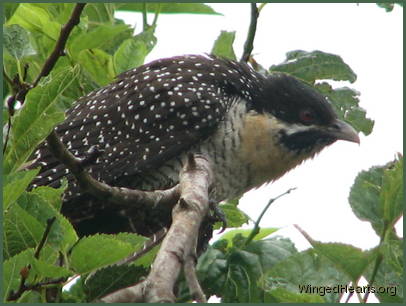 The first time a bird sees a camera, he/she may feel a bit unsure of the big thing we place next to our eyes that also makes a clicking sound. But in no time at all, they realise that the sound poses no danger to them. Once they become comfortable with the sound, they feel quite amused by our fondness for pointing this object towards them.
The first time a bird sees a camera, he/she may feel a bit unsure of the big thing we place next to our eyes that also makes a clicking sound. But in no time at all, they realise that the sound poses no danger to them. Once they become comfortable with the sound, they feel quite amused by our fondness for pointing this object towards them.
We use a Cannon S5 with a 1.5 teleconverter lens which is a reasonable sized equipment. To the bird it looks like we have added a big round black giant sized eye to our eye.
The birds have no idea what the camera really does for us, but that doesn't stop them from appreciating many things about it, in their classic style of observing our actions.

Submitted by Gitie on 27 June, 2010 - 00:13
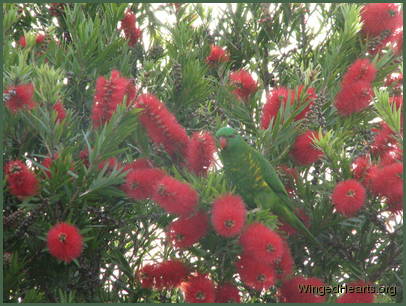 In order to understand birds, one has to pay attention with both ones ears and eyes. In other words we need to hear the sounds they are making while also following their actions. I call this 'Listening With Your Eyes'.
In order to understand birds, one has to pay attention with both ones ears and eyes. In other words we need to hear the sounds they are making while also following their actions. I call this 'Listening With Your Eyes'.
Birds love chattering and sharing the days news with each other. Every bird species has its own language. The different species don't have much difficulty following each other. The birds also have a range of soft almost inaudible 'mm', 'bb' type sounds and a lot of their communication is also non-verbal.

Submitted by Gitie on 26 June, 2010 - 00:19
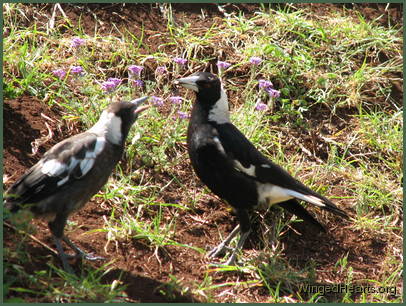 Today I'm going to show you some examples of the way birds use 'show and tell' as a way of communicating with us (and also each other).
Today I'm going to show you some examples of the way birds use 'show and tell' as a way of communicating with us (and also each other).
Consider the following two cases:
1. A group of magpies flies overhead headed towards the north. Our magpies sing out to them as they fly over. After a few chords they continue doing whatever activities had occupied them before.

Submitted by Gitie on 25 June, 2010 - 00:36
This is one of the first pictures I took of our birds back in 2001 with a film camera. (Any one remember those things that had to be handled carefully and in the dark?)
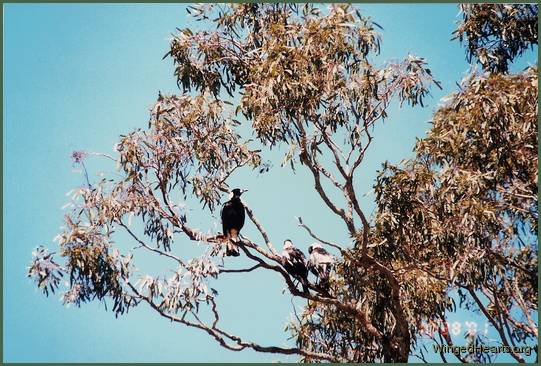
Here sitting on an old gum tree is Molly the mother magpie teaching juvis Maggie and Cindy to sing. They had the most brilliant voices and loved singing at top volume. This was during my early days of friendship with them.
In today's post we will explore tips 4-7 of getting to know your wild birds.

Submitted by Gitie on 24 June, 2010 - 01:00
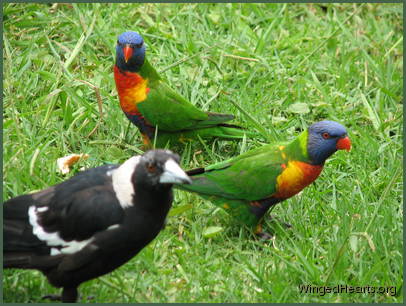 By now you will have a few friends whom you recognise and call by name. The next stage is to get o know more about your birds.
By now you will have a few friends whom you recognise and call by name. The next stage is to get o know more about your birds.
There are seven main points that you can follow to further develop your relationship with your new wild bird friends. These are:
1. Make Time For Regular Interaction
2. Learn More About The Species
3. Gain Insight's Into Your Individual Bird Friends
4. Listen for Cues
5. Notice Changes In their Behaviour
6. Keep a Daily Journal
7. Look for Wider Patterns and Stories

Pages

 The first time a bird sees a camera, he/she may feel a bit unsure of the big thing we place next to our eyes that also makes a clicking sound. But in no time at all, they realise that the sound poses no danger to them. Once they become comfortable with the sound, they feel quite amused by our fondness for pointing this object towards them.
The first time a bird sees a camera, he/she may feel a bit unsure of the big thing we place next to our eyes that also makes a clicking sound. But in no time at all, they realise that the sound poses no danger to them. Once they become comfortable with the sound, they feel quite amused by our fondness for pointing this object towards them. In order to understand birds, one has to pay attention with both ones ears and eyes. In other words we need to hear the sounds they are making while also following their actions. I call this 'Listening With Your Eyes'.
In order to understand birds, one has to pay attention with both ones ears and eyes. In other words we need to hear the sounds they are making while also following their actions. I call this 'Listening With Your Eyes'. Today I'm going to show you some examples of the way birds use 'show and tell' as a way of communicating with us (and also each other).
Today I'm going to show you some examples of the way birds use 'show and tell' as a way of communicating with us (and also each other).
 By now you will have a few friends whom you recognise and call by name. The next stage is to get o know more about your birds.
By now you will have a few friends whom you recognise and call by name. The next stage is to get o know more about your birds. 



